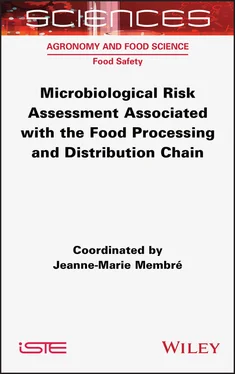– Reservoirs: any living being (human, animal or plant), soil or combination of these upon which a pathogen is primarily dependent for its survival, multiplication and/or reproduction. The reservoir of a pathogen can therefore be animal (e.g. for Campylobacter or Salmonella), human (e.g. for norovirus or hepatitis A virus), environmental (e.g. for Bacillus cereus) or mixed (e.g. for Listeria monocytogenes or hepatitis E virus).
– Vehicles: any object or substance which acts as a medium in the transmission of a pathogen from the reservoir to its introduction into a receptive host. In the case of foodborne infections, vehicles are foods contaminated with biohazards (in other words, pathogens or their toxic metabolites). Vehicles can also be environmental (e.g. recreational waters).
A report by ANSES (2018) makes it possible to identify which hazards are linked to which categories of food and/or which sectors. The foods under consideration are milk and dairy products, eggs and egg-based preparations, fishery products, meats, vegetables and composite dishes. For meat, it is possible to narrow it down to the sector level: bovine, porcine, small ruminants, poultry or laying hens. For the fishing industry, a distinction can be made between the fish sector and the mollusk and crustacean sector. This work has been published (Augustin et al. 2020) and its chief findings are set out in the Appendices.
Another rich source of information, which is regularly updated, is the documentary collection of the International Commission on Microbiological Specifications for Foods (ICMSF; https://www.icmsf.org/). The sixth book in this series, entitled Microbial Ecology of Food Commodities , provides a great deal of information on microbial hazards that can be very useful in a hazard analysis. The book is structured into product categories including meat and meat products, milk and dairy products, poultry products, eggs and egg products, fish and fishery products, cereals and cereal products, vegetables and vegetable products, etc.
With regard to microorganisms and their ability to multiply, their resistance to stress, their survival and their inactivation, the information resulting from validated forecasting models can and must be taken into account. In particular, these models make it possible to quickly assess the potential barrier effects. The scientific literature is full of model and application developments. We recommend the reader look first at summary works (McKellar and Lu 2004; Membré and Valdramidis 2016; Valdramidis et al. 2017), starting with Chapter 3of this book (Exposure Assessment of Microbial Pathogens). In section 1.5, the cook/chill/pH barrier measure against non-proteolytic Clostridium botulinum is presented. It is based on the development of a forecasting model applicable to refrigerated, vacuum-packed foods that have received heat treatment sufficient to give them a shelf life (SL) of four weeks or more, with no added preservatives.
Data that are useful for hazard identification, or at least some of these data and assuming the associated metadata (e.g. year, season, geographical location, country) are accessible, can be used in the other stages of microbial risk assessment. As an example, the work carried out by Membré et al. (2015) in their study on the risk linked to foie gras is presented in the next section.
1.4. An example of the use of data in hazard identification, exposure assessment and risk characterization
The example developed below is based on the work of Membré et al. (2015) on canned foie gras.
Non-acidic canned items require the application of thermal processing to render them healthy, safe and atmospherically stable. The preparation of canned food involves placing the foodstuffs into packaging that is impermeable to gases, liquids and microorganisms, then heating them to a temperature above 100 °C for a variable period of time depending on the food. The temperature charts (time–temperature relationships) that have been used for decades have usually been defined empirically, with the sights set on the main microbiological hazard associated with the manufacture of canned food, proteolytic Clostridium botulinum , a sporulating anaerobic mesophilic bacterium (Frazier 1967; Stumbo 1973).
It is generally accepted that a treatment equivalent to at least a temperature of 121.1°C for three minutes (conferring a sterilizing value of three minutes) allows an inactivation of an order of magnitude of 12 log of proteolytic C. botulinum spores, and this is the standard for the thermal processing of low-acid foods that are ambiently stable. However, some canned products with an excellent safety history receive a heat treatment below this three minute sterilization value.
For example, the microbiologically safe processing of canned nitritated charcuterie (pâté) relies on mild thermal processing in combination with the presence of nitrite salt in the formulation in order to prevent the growth and formation of toxins from a low level of spores (Anderson et al. 2011). Similarly, despite being subject to fairly mild thermal processing, canned foie gras has a proven safety record: no cases of botulism attributed to this product had been reported in the 10 years prior to the study in France (INVS 2013), where 90% of France’s output is sold, and moreover, no cases had been reported in the literature (Internet search on www.promedmail.org, www.eurosurveillance.org, www.ncbi.nlm.nih.gov/and archive.org, which documented more than 700 cases of food botulism from 1918 to 2013).
However, epidemiological data do not provide sufficient evidence to draw firm conclusions on food safety. The authors of the study therefore decided to build a quantitative microbial risk assessment model in order to assess the potential risk associated with proteolytic C. botulinum in canned foie gras.
In order to estimate the initial level of contamination of raw foie gras at the stage of their exposure assessment, they used data from manufacturers. Sampling was carried out over nine months with the help of 14 French companies representative of various scales of canning operations. Three hundred and seventy-two raw foie gras samples were taken just before sterilization; they were frozen and sent to the laboratory for analysis. A specific direct count of C. botulinum not being possible, a series of steps were carried out. First of all, the count of bacteria forming anaerobic spores was carried out according to the French standard NF V 08-602 (AFNOR 2011) with one modification (a change in the processing temperature). Only the black colonies were counted because they correspond to the Clostridium type. Identification involved partial sequencing of the coding region of 16S rRNA. Finally, for all isolates identified as C. sporogenes or C. botulinum , specific identification of the C. botulinum genes was carried out according to a variety of protocols (Raphael and Andreadis 2007; Fach et al. 2009; Woudstra et al. 2012).
To estimate the level of risk affecting the French population and to use that to validate the estimated level of risk during the study, epidemiological data covering the period 2001–2012 were collected and analyzed. In France, information on botulism epidemics is compiled each year by the National Institute for Public Health Surveillance (INVS 2013). The data for the 12 years were extracted and then analyzed to estimate the number of cases per million inhabitants in France.
The quantitative risk assessment model estimated, with current consumption, an average probability of illness of 8.0 x 10 -10per inhabitant and per year. This value is very low, which led to the conclusion that current practices in terms of the thermal processing of canned foie gras were sufficient to control the risk of the presence of C. botulinum in foie gras in France.
Читать дальше












